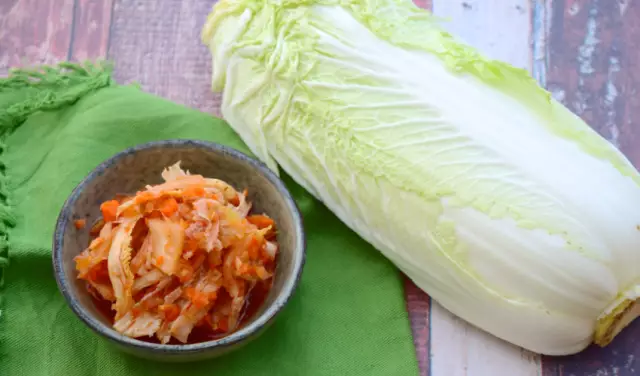- Author Rachel Wainwright [email protected].
- Public 2023-12-15 07:39.
- Last modified 2025-11-02 20:14.
Carp
Crucian carps are fish of the carp family (carp order). Sea crucians are coastal fish that live in the Black Sea. Freshwater crucians live in lakes and rivers.
The ratio of BJU in the product

Source: depositphotos.com How to burn 87 kcal?
| Walking | 22 minutes |
| Jogging | 10 min. |
| Swimming | 7 minutes |
| A bike | 12 minutes |
| Aerobics | 17 minutes |
| Household chores | 29 minutes |
The fish has a high body, moderately compressed sides, a large back and smooth scales. The length of a freshwater crucian carp can be up to sixty centimeters. The average size of a sea carp is 13-16 centimeters. The weight and size of the fish depend on the location and conditions of its habitat.
There are three types of freshwater carp: silver carp, common carp, goldfish. Goldfish is an ornamental aquarium fish, artificially bred in China. Goldfish is less demanding in nutrition and multiplies faster, therefore it very often replaces other types of fish.
Nutritional value and calorie content of crucian carp
About 60% of the carp's body is suitable for human consumption. The calorie content of crucian carp is only 88 kcal, while the more fatty varieties of fish contain 3 times more calories (up to 250 kcal per hundred grams of fish).
There is very little fat in the pulp of this fish (about 7%), but a lot of easily digestible and low-calorie protein (18%). Due to the low calorie content, crucian carp is often included in the medical menu for overweight, with various cardiovascular pathologies (baked or boiled).
Properties and benefits of crucian carp
The quality of this fish is highly dependent on its habitat. In swampy lakes, freshwater crucian carp often smells like algae. The best-tasting fish is found in clean large reservoirs. In addition, there it is larger and does not have any foreign odors.
The benefit of crucian carp for the human body is that its pulp contains a group of essential amino acids. Essential amino acids help to increase intelligence and speech abilities, improve vision.
The pulp of this fish contains vitamins A, C, E, vitamins of group B, as well as minerals - sodium, magnesium, calcium, phosphorus, iron, fluorine, potassium, chlorine, nickel, chromium, molybdenum. Therefore, crucian carp must be used to prevent the development of cancer, as well as to increase the body's resistance to various infections.
Sea carp is rich in polyunsaturated fatty acids Omega-3, which support the health of the brain, blood vessels, heart and the whole body as a whole.
In addition, the benefit of crucian carp is that the pulp of this fish stimulates the digestive system, activates the synthesis of enzymes.
The body of the sea carp has the highest content of the trace element iodine among all the fish living in the sea. Therefore, this fish should be eaten in large quantities for thyroid diseases.
An important benefit of crucian carp is due to the high content of calcium, which helps to strengthen bones, nails and hair.
WHO recommends consuming 100 g of crucian carp at least three times a week. Research has shown that eating fish daily and avoiding other protein sources (meat, chicken, etc.) does not harm the body.
Only fresh fish can benefit the body. Fresh fish is covered with transparent mucus, its gills are bright red or light pink, the scales are shiny. The surface of the stale fish is covered with cloudy mucus, and the scales are pale and faded. The belly of stale fish may be swollen.
Ways of cooking crucian carp
Crucian carp is widely used in cooking. There are many ways to prepare this fish. It can be fried, marinated, dried, baked, boiled fish soup or jelly with it, smoked or dried. The fish should be cooked with spices to remove the algae smell characteristic of crucian carp. Before cooking, crucian carp, like any freshwater fish, should be rinsed with concentrated saline solution. It is better to cut large fish into pieces, and cook small fish whole.
Before you bake the carp in the oven, you need to make several small cuts along the ribs so that the fish is baked better.
Carp fish soup is very useful for people suffering from ulcers or gastritis.
During heat treatment, the flesh of crucian carp should not be overcooked or overcooked. For this fish, ten minutes of cooking and fifteen minutes of frying are enough. When overheated, the flesh of the fish becomes tough and dry.

Fried fish with sour cream is the most famous way to cook crucian carp. A rare dish, but no less tasty and healthy, is crucian carp, boiled in cream.
The fish can be salted and the flesh turns red. In Korea, this fish is most often steamed according to the Tomimyon recipe (with mushrooms, beef and nuts).
The skeleton of a crucian carp consists of many small bones. That is why some culinary experts advise deep-frying it. In it, almost all small bones seem to dissolve, and large ones become crispy and brittle.
YouTube video related to the article:
Found a mistake in the text? Select it and press Ctrl + Enter.






